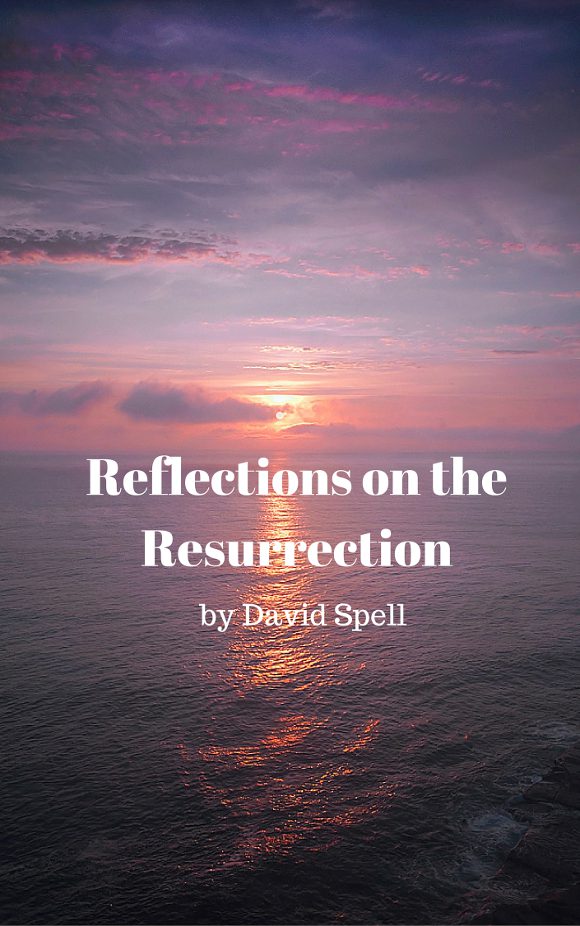
*Easter is getting close. Here’s a chapter from my book Reflections on the Resurrection. Enjoy!
Three Women, A Couple of Angels, and an Empty Tomb
“But very early on Sunday morning the women came to the tomb, taking the spices they had prepared. They found that the stone covering the entrance had been rolled aside. So they went in, but they couldn’t find the body of the Lord Jesus. They were puzzled, trying to think what could have happened to it. Suddenly, two men appeared to them, clothed in dazzling robes. The women were terrified and bowed low before them. Then the men asked, “Why are you looking in a tomb for someone who is alive? He isn’t here! He has risen from the dead! Don’t you remember what he told you back in Galilee, that the Son of Man must be betrayed into the hands of sinful men and be crucified, and that he would rise again the third day?” (Luke 24:1-7)
The role of women in first century Palestine was very limited. They had few rights and in many ways were regarded as inferior. A common Jewish male prayer was to thank God that he was not born “a Gentile, a slave or a woman.” In other parts of the world, women held slightly higher roles than they did in Hebrew society. All in all, however, a woman’s role in the first century was difficult.
In light of the restricted societal role that women had at the time of Christ, it comes as a surprise to see what a large part that they played in Jesus’ ministry. In Luke 8:1-3, for example, Luke talks about the women who were part of Jesus’ inner circle of followers. They traveled with him and the other disciples and helped to fund their work. From this passage and several others, it is clear that women played an important role in helping Jesus during his preaching and teaching tours.
When Jesus was crucified, the women showed more courage than Jesus’ male disciples. Perhaps because they were not perceived as a revolutionary threat, several women, including Jesus’ mother, were allowed to witness the crucifixion. With the exception of John, the rest of Jesus’ followers were in hiding.
After Jesus died, Joseph of Arimathea asked for permission to take custody of the body. Three of the four Gospels note that at least two women were present during this process, Mary Magdalene and Mary, Jesus’ mother. Luke records that the women traveled to the tomb where Jesus’ body was laid to rest.
“Then they went home and prepared spices and ointments to embalm him. But by the time they were finished it was the Sabbath, so they rested all day as required by the law.” (Luke 23:56) Their intention was to come back after the Sabbath and finish preparing Jesus’ body for burial.
On that Sunday morning, however, when the women went to the tomb to finish taking care of Jesus’ body, they found that the heavy stone had already been rolled away and the tomb was empty. Well, it was not completely empty. Jesus’ body was not in the tomb. Instead, there were angels inside to greet the women. In Luke, the angels ask the women, “Why are you looking among the dead for someone who is alive? He isn’t here! He is risen from the dead!” (Luke 24:5-6)
In Matthew’s account, Jesus appeared to the women as they left the tomb to find the disciples. In John’s Gospel, the first person that Jesus appears to is Mary Magdalene. It is fascinating that these women were the first witnesses of the resurrection. One would think that Jesus might have appeared to his closest followers first. Instead, he revealed himself to a few women and then instructed them to pass the good news on to the others.
Of course, Jesus did appear to many other people after his resurrection. There was a forty day period between Jesus’ resurrection and his ascension back into Heaven. During that time Jesus made multiple appearances to his disciples and other followers. The Apostle Paul details this in his First Corinthian letter.
Paul provides us with the order of Jesus’ resurrection appearances. “He was seen by Peter and then by the twelve apostles. After that, he was seen by more than five hundred of his followers at one time, most of whom are still alive, though some have died by now. Then he was seen by James and later by all the apostles. Last of all, I saw him, too, long after the others, as though I had been born at the wrong time.” (1 Corinthians 15:5-8)
The question that immediately comes up when examining this passage by Paul is, “Why doesn’t he make mention of the women who saw Jesus first on that resurrection morning?” The answer to this question goes back to the beginning of this chapter. A first-century woman had very few rights. She could not testify in court because the testimony of a woman would never be considered valid. In other words, a woman could not be considered as a competent witness.
In this important chapter in First Corinthians, the Apostle Paul was building a case for Jesus’ resurrection. In Corinth, false teachers had attacked the validity of the physical resurrection of Jesus and argued that it had never occurred. In response to this, Paul wrote this incredible chapter, arguing for and defending the resurrection of Jesus from the dead.
In the first part of the chapter, which is quoted and listed above, Paul provides a list of people who saw the risen Jesus. He does not include the women because they would not qualify as eye-witnesses. Including them in this list would have weakened the case that Paul was making.
This exclusion of the women as eye-witnesses by the Apostle Paul makes their inclusion by the four Gospel writers even more incredible. Unlike Paul, Matthew, Mark, Luke and John were simply telling their story of Jesus’ crucifixion and resurrection. They were not building a case against false teachers. They were not even concerned so much about whether or not their accounts would be considered legally admissible in court.
For the Gospel writers, it was more important to communicate the story of Jesus’ resurrection as they had received it. They just wanted to let their readers know what happened on that Sunday morning. This meant that several first-century women would be right in the middle of the story.
Food for Thought- Have you ever considered how Christianity has made a difference for groups of people that others might consider inferior? How has Christianity made life better for women, children, and other marginalized people groups through history?
David and Annie are serving the Lord in the United States, Africa, India, and Brazil. Would you consider joining their team? Just click here to get involved. Thanks so much!

